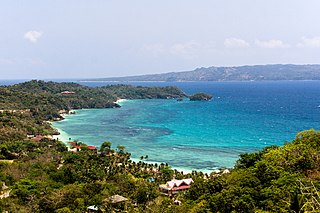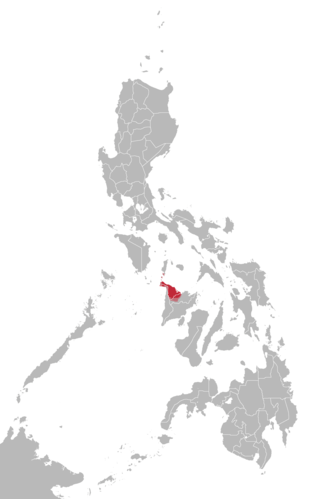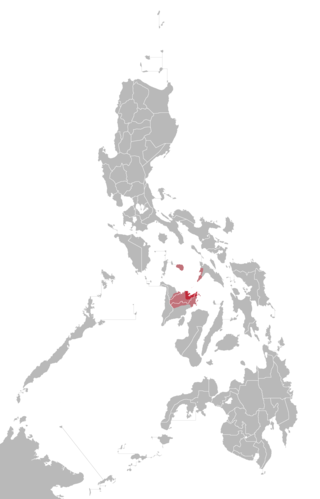
The Visayas, or the Visayan Islands, are one of the three principal geographical divisions of the Philippines, along with Luzon and Mindanao. Located in the central part of the archipelago, it consists of several islands, primarily surrounding the Visayan Sea, although the Visayas are also considered the northeast extremity of the entire Sulu Sea. Its inhabitants are predominantly the Visayan peoples.

Panay is the sixth-largest and fourth-most populous island in the Philippines, with a total land area of 12,011 km2 (4,637 sq mi) and a total population of 4,542,926, as of 2020 census. Panay comprises 4.4 percent of the entire population of the country. The City of Iloilo is its largest settlement with a total population of 457,626 inhabitants, as of 2020 census.

Iloilo, officially the Province of Iloilo, is a province in the Philippines located in the Western Visayas region. Its capital and largest city is Iloilo City, the regional center of Western Visayas. Iloilo occupies the southeast portion of the Visayan island of Panay and is bordered by the province of Antique to the west, Capiz to the north, the Jintotolo Channel to the northeast, the Guimaras Strait to the east, and the Iloilo Strait and Panay Gulf to the southwest.

Aklan, officially the Province of Aklan, is a province in the Western Visayas region of the Philippines. Its capital is Kalibo. The province is situated in the northwest portion of Panay Island, bordering Antique to the southwest, and Capiz to the southeast. Aklan faces the Sibuyan Sea and Romblon province to the north.

Capiz, officially the Province of Capiz, is a province in the Philippines located in the central section of Western Visayas region. Its capital is the city of Roxas. It is located at the northeastern portion of Panay Island, bordering Aklan to the north, Antique to the west, and Iloilo to the south. Capiz faces the Sibuyan Sea to the north.

Western Visayas is an administrative region in the Philippines, numerically designated as Region VI. It consists of five provinces: Aklan, Antique, Capiz, Guimaras, and Iloilo. The region also includes one highly urbanized city, Iloilo City, which is the largest city and serves as the regional center.

Visayans or Visayan people are a Philippine ethnolinguistic family group or metaethnicity native to the Visayas, the southernmost islands of Luzon and a significant portion of Mindanao. They are composed of numerous distinct ethnic groups, many unrelated to each other. When taken as a single group, they number around 33.5 million. The Visayans, like the Luzon Lowlanders were originally predominantly animist-polytheists and broadly share a maritime culture until the 16th century when Catholicism was introduced by the Spanish empire. In more inland or otherwise secluded areas, ancient animistic-polytheistic beliefs and traditions either were reinterpreted within a Roman Catholic framework or syncretized with the new religion. Visayans are generally speakers of one or more of the distinct Bisayan languages, the most widely spoken being Cebuano, followed by Hiligaynon (Ilonggo) and Waray-Waray.

Kalibo, officially the Municipality of Kalibo, is a first-class municipality and capital of the Province of Aklan, Philippines. According to the 2020 census, it has a population of 89,127 people.

The Kalibo Santo Niño—Ati-Atihan Festival, also simply called Ati-Atihan Festival, is a Philippine festival held annually in January in honor of the Santo Niño in several towns of the province of Aklan, Panay Island. The biggest celebration is held during the third Sunday of January in the town of Kalibo, the province's capital. The name Ati-Atihan means "to imitate the Ati people".
Datu Kalantiaw is a widely publicized pseudohistorical figure based on an early 20th-century hoax by José Marco. Kalantiaw was credited with allegedly creating the first legal code in the Philippines, known as the Code of Kalantiaw in 1433. He gained national prominence in the 20th century in the Philippines, particularly in the island of Panay where allegedly held office.

Numancia, officially the Municipality of Numancia, is a 4th class municipality in the province of Aklan, Philippines. Because of its proximity to the Capital Town of Kalibo, majority of its baranggays are classified as urbanized making the municipality the second most densely populated municipality in the province with 1,200 inhabitants per square kilometres. According to the 2020 census, it has a population of 35,693 people.
The Hiligaynon people, often referred to as Ilonggo people or Panayan people, are the second largest subgroup of the larger Visayan ethnic group, whose primary language is Hiligaynon, an Austronesian language of the Visayan branch native to Panay, Guimaras, and Negros. They originated in the province of Iloilo, on the island of Panay, in the region of Western Visayas. Over the years, inter-migrations and intra-migrations have contributed to the diaspora of the Hiligaynon to different parts of the Philippines. Today, the Hiligaynon, apart from the province of Iloilo, also form the majority in the provinces of Guimaras, Negros Occidental, Capiz, South Cotabato, Sultan Kudarat, and North Cotabato.

Aklanon (Akeanon), also known as Bisaya/Binisaya nga Aklanon/Inaklanon or simply Aklan, is an Austronesian language of the Bisayan subgroup spoken by the Aklanon people in the province of Aklan on the island of Panay in the Philippines. Its unique feature among other Bisayan languages is the close-mid back unrounded vowel occurring as part of diphthongs and traditionally written with the letter ⟨Ee⟩ such as in the autonyms Akean and Akeanon. However, this phoneme is also present in other but geographically scattered and distant Philippine languages, namely Itbayat, Isneg, Manobo, Samal and Sagada.

The Ati are a Negrito ethnic group in the Visayas, the central portion of the Philippine archipelago. Their small numbers are principally concentrated in the islands of Boracay, Panay and Negros. They are genetically related to other Negrito ethnic groups in the Philippines such as the Aeta of Luzon, the Batak of Palawan, the Agta of the Sierra Madres, and the Mamanwa of Mindanao.
Cuyonon refers to an ethnic group populating the Cuyo Islands, along with northern and central Palawan. The Cuyonons hail originally from Cuyo and the surrounding Cuyo Islands, a group of islands and islets in the northern Sulu Sea, to the north east of Palawan. They are considered an elite class among the hierarchy of native Palaweños. They are part of the wider Visayan ethnolinguistic group, who constitute the largest Filipino ethnolinguistic group.

The Maragtas is a work by Pedro Alcantara Monteclaro titled History of Panay from the first inhabitants and the Bornean immigrants, from which they descended, to the arrival of the Spaniards. The work is in mixed Hiligaynon and Kinaray-a languages in Iloilo in 1907. It is an original work based on written and oral sources available to the author.
The Suludnon, also known as the Panay-Bukidnon, Pan-ayanon, or Tumandok, are a culturally indigenous Visayan group of people who reside in the Capiz-Antique-Iloilo mountainous area of Panay in the Visayan islands of the Philippines. They are one of the two only culturally indigenous group of Visayan language-speakers in the Western Visayas, along with the, Halawodnon of Lambunao and Calinog, Iloilo and Iraynon-Bukidnon of Antique. Also, they are part of the wider Visayan ethnolinguistic group, who constitute the largest Filipino ethnolinguistic group.

The Confederation of Madja-as was a legendary pre-colonial supra-baranganic polity on the island of Panay in the Philippines. It was mentioned in Pedro Monteclaro's book titled Maragtas. It was supposedly created by Datu Sumakwel to exercise his authority over all the other datus of Panay. Like the Maragtas and the Code of Kalantiaw, the historical authenticity of the confederation is disputed, as no other documentation for Madja-as exists outside of Monteclaro's book. However, the notion that the Maragtas is an original work of fiction by Monteclaro is disputed by a 2019 Thesis, named "Mga Maragtas ng Panay: Comparative Analysis of Documents about the Bornean Settlement Tradition" by Talaguit Christian Jeo N. of the De La Salle University who stated that, "Contrary to popular belief, the Monteclaro Maragtas is not a primary source of the legend but is rather more accurately a secondary source at best" as the story of the Maragtas also appeared in the Augustinian Friar, Rev. Fr. Tomas Santaren’s Bisayan Accounts of Early Bornean Settlements Additionally, the characters and places mentioned in the Maragtas book, like Rajah Makatunaw and Madj-as can be found in Ming Dynasty Annals and Arabic Manuscripts. However, the written dates go earlier since Rajah Makatunaw was recorded to have been from 1082 AD and was a descendant of Seri Maharajah while the Code of Maragtas, a separate work from the Maragtas book, placed him at the 1200s.

Capiznon or Capiceño is an Austronesian regional language spoken in Western Visayas in the Philippines. Capiznon is concentrated in the province of Capiz in the northeast of Panay Island. It is a member of the Bisayan language family and the people are part of the wider Visayan ethnolinguistic group, who constitute the largest Filipino ethnolinguistic group. The language is often confused with Hiligaynon due to dialectological comprehension similarities and as high as 91% mutual intelligibility, but it has its certain unique accent and vocabulary that integrates Aklanon and Waray lexicon. Despite its distinct corruption of Hiligaynon lateral approximants, a prevalent feature among rural farmers, ethnic convergence and cosmopolitanism has led to a shift back to the purely Hiligaynon prosodic form of slower tonality and softer and longer vowels most particularly among the younger generations.
Ati (Inati), or Binisaya nga Inati, is an Austronesian language of the island of Panay in the Philippines. The variety spoken in northern Panay is also called Sogodnin. The Ati people also speak Kinaray-a and Hiligaynon.















